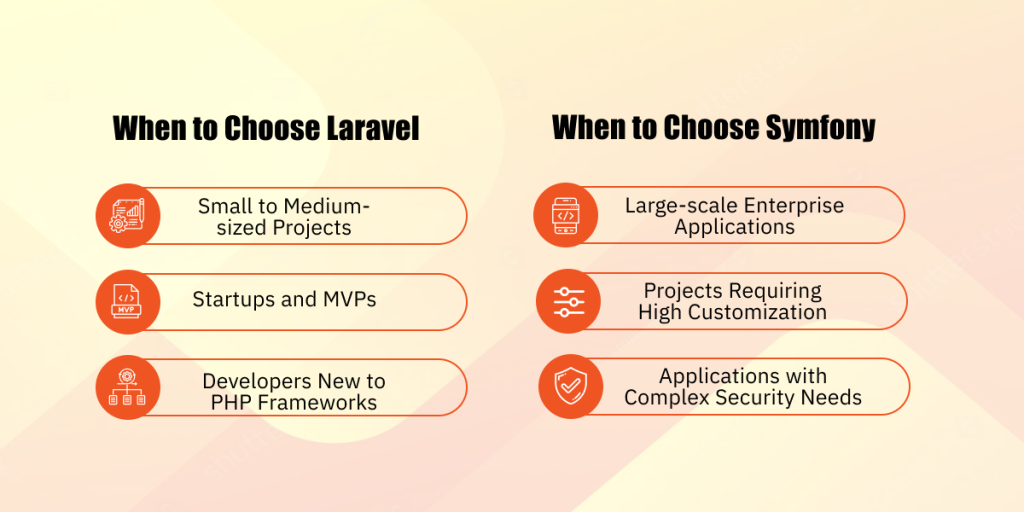
Laravel vs Symfony – An In-Depth Analysis to Pick the Right Platform?
The selection of the right framework is always considered one of the most strategic decisions when a new web development project begins. In the PHP development environment, two broadly used frameworks are Laravel website development and Symfony.
They are both effective and efficient methodologies that respond to different requirements and approaches. In this article we will review both Laravel and Symfony in detail – their principles, usage, relative simplicity and efficiency, system extensibility, and others.
Laravel web development was first immediately embraced by the community and for good reasons, primarily its syntax and documentation and the number of features that would come with it.
Since that time, it has become one of the more popular PHP frameworks, especially for the many developers who prefer simplicity and speed.
While Symfony has had a somewhat longer history, having been released by Fabien Potencier in 2005. It is noteworthy that Symfony was intended by its creators as a framework that should be as adaptable and reusable as possible, following the purest standards and practices.
Core Philosophy and Design Patterns

The main concept behind Laravel is to be as simple, elegant, and as easy to work with as possible.
It uses the Model 2 architecture i.e., the Model-view-controller (MVC) architectural approach that divides an application into three components namely model, view, and controller.
Laravel website development comes in well-structured PHP syntax that is easy to understand by new developers in custom PHP Web development.
There are several constructed toys and gismos that are included in the framework and can help minimize the amount of work one has to do that is inconsequential to the actual implementation of features.
While CakePHP repeats the concepts of resource nonsense and without-the-framework conclusions, Symfony focuses on flexibility, reusability, and naming conventions with an additional factor – references to the best practices.
This leaves the Web broken into component-based architecture, a trend that lets the developers make use of only the components they require.
Like Laravel, Symfony also uses the MVC architecture, but it gives a certain level of flexibility about its implementation.
This gives Symfony great flexibility, but it is much more difficult for a programmer who decides to work with this framework for the first time.
Many components of Symfony are designed to compel developers into creating applications that are easy to maintain, scalable, and testable.
Also Read : How To Develop A Scalable eCommerce Website in PHP
Ease of Use and Learning Curve
Many people prefer Laravel web development due to its simplicity, and navigability if you are a beginner at scripting languages. The documentation devoted to the framework is well done and systematized, so inexperienced developers will not take long to get started.
Laravel is compatible with PHP and has pathways that provide tooltips by default and tools such as routing, authentication, and database management incorporated by default.
Laravel has a strong community with many forums, blogs, and tutorials available for use.
However, Symfony is flexier than Laravel software development, it’s harder to get into. Though the framework and its application are rather flexible and adjusted to using best practices, the developers should have profound knowledge of Object-Oriented Programming and Design Patterns.
Documentation of the Symfony Framework is very well done though because of its scale and complexity new users may get lost.
But when developers have learned how to use Symfony, this framework turns out to be both a very gratifying and very potent tool, especially for large-scale applications.
Performance and Scalability
In terms of performance, both Laravel and Symfony can scalability to handle the traffic of applications, though there are differences in the methodologies used. Laravel was designed to be very quick and easy to develop, and this means that in very large applications there will be some compromises to performance.
But Laravel website development has tools that include caching, optimizing the database, and job queues that would help in the performance.
Performance-wise, Laravel web design is generally satisfactory for most small to medium applications.
Before we go any further, there is something you must understand about Symfony: Symfony is performance and scalability ready. Modularity lets the developers work on the fine-tuning of different components of the application to achieve the best outcomes in huge and intricate projects.
Components of Symfony are implemented in other frameworks and projects that are highly efficient and reliable including laravel_FRAMEWORK.
For enterprise-level applications or project requirements where performance is a matter of concern, then the architectural foundation of Symfony is more flexible as well as more optimized.
Also Read : PHP Web Development : Everything You Need to Know
Development Speed and Productivity
Laravel has been known to greatly improve development speeds, which in turn increases development productivity. Among the components of the framework are languages and components aimed at making frequent jobs easier.
However, these features make Laravel website development ideal for projects that are on a tight schedule or require a quick prototype to be developed.
Symfony also contains a vast array of tools, but it is more of a framework for creating Agile applications that are flexible and can be easily adjusted.
Doctrine ORM, which is the object-relational mapper provided by the Symfony framework, is very powerful and rather more flexible, but it comes with a basic understanding of how databases are structured.
Admittedly, the Twig engine used in Symfony has more features than Blade, though to make productive use of it one must invest more effort and time. As for Symfony CLI, Artisan has an equivalent but with more settings available for automation.
This focus on flexibility makes Symfony slightly slower or starting the application, but it has far less payback for complex applications.
Ecosystem and Community Support
Laravel also has one of the best-supporting ecosystems around it. Laravel has a vast trove of tools and services as well; Laravel Forge (a server management tool), Vapor (a serverless deployment tool), and Laravel Nova (an administration panel building tool).
These tools are by default interoperable or are easily compatible with Laravel, forming a strong and integrated environment.
Laravel framework development also has a very active community that has suggested a wide list of packages, extensions, and resources that in a way also expand the functionality offered by the framework.
The active community surrounding Laravel therefore makes it ideal for developers who wish to harness already existing frameworks to speed up the development processes.
However, Symfony has a rather more limited base, but it is extremely modular and can be used in virtually all kinds of applications.
Many other custom PHP Web development projects use Symfony’s components: Laravel, for example, which says a lot about the quality of these components.
Although Symfony does not boast as extensive a community as Laravel, the Symfony community of users is quite professional and many of them work together on large and enterprise projects.
If you require a great deal of customization and are willing to configure your development environment to precisely your needs, then Symfony’s ecosystem is a good fit for you.
Customization and Flexibility
Laravel website development is somewhat customizable, but what you get is ‘never-the-less’ a lot of out of the box. This makes it easy to work with but can also at times be a con because, for a developer who may require making certain modifications not provided by the framework, it may be hard to do so.
But the middleware of Laravel along with the service container can be heavily customized if required. For projects that are not fully bespoke yet can leverage a lot from an opinionated framework like Laravel, it is perfect.
For highly flexible architectures, most of the projects of web development go for Symfony. The fact that it is based on components enables the developers to create only what is required without having to add more ‘weight’ than is needed.
One of the major principles of Symfony is the ‘Convention over Configuration’ principle, however, Symfony has opted for more structure and flexibility where developers have a great deal of control over every aspect of the application including routing, templating, and security.
This makes Symfony uniquely suitable for rather intricate tasks when Stock solutions will not do.
Security Features
When it comes to security, Laravel and Symfony do not differ much because the security is cared for by the developers and both frameworks have dedicated security features for protecting applications against breaches.
This is standard in Laravel’s security that includes protection against Cross-Site Request Forgery (CSRF), Cross-Site Scripting (XSS), and SQL injection. Fortunately, Laravel incorporates authentication, and while using the framework, encryption services are available for important data.
These characteristics make Laravel to be quite secure for most applications while there is no need for complex hard settings.
Also Read : Boost Your Online Success by Mastering E-commerce with PHP
Symfony has more sophisticated and customizable measures of security. The Symfony Security Component offers high-quality instruments for end-users for authorization, authentication, and encryption.
Symfony also facilitates other areas of security needs, for instance role-based access control (RBAC) and LDAP facilities.
For projects with stringent security needs or those operating in highly regulated industries, Symfony’s security offerings provide the necessary depth and flexibility.
Use Cases and Suitability
Many times, when comparing Laravel to Symfony, it is difficult to ascertain one is better than the other, this will depend on your project.

When to Choose Laravel:
Small to Medium-sized Projects: While Laravel and other frameworks are powerful and easy to use for building and developing applications, it is recommendable for developing smaller projects so that this time can be utilized to ensure that products get to the market as soon as possible.
Startups and MVPs: Laravel has been precisely designed for prototyping and rapidly developing new features, which is great for startups.
Developers New to PHP Frameworks: It would be recommended to start with Laravel as it has great and easy-to-understand syntax and documentation for people who are not familiar with PHP frameworks as much.
When to Choose Symfony:
Large-scale Enterprise Applications: Therefore, Symfony is more suitable for large and complex projects due to its flexibility, performance, and scalability.
Projects Requiring High Customization: Therefore, Symfony is a perfect choice for projects with extraordinary needs because it does not practice a rigid approach to their structure.
Applications with Complex Security Needs: One advantage of Symfony is its use in projects with stringent security and compliance standards since it has enhanced security aspects.
Concluding Thoughts
Laravel website development is one of the most popular custom PHP Web development frameworks while Symfony is more heavy-weighted, but in fact, both frameworks are rather powerful and suitable for different projects. Laravel is best for simple, easy-to-use, and fast development.

